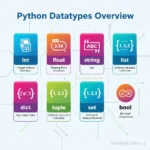Let’s be honest—when you first hear the word “Python Variables”, your brain probably flashes back to high school algebra trauma:
“If x = 2 and y = 3, then what is x + y?”
Answer: My blood pressure rising. 😤
But don’t panic! In Python, variables aren’t scary math demons. They’re more like sticky notes you slap on your computer’s memory:
- “This is my name 🏷️”
- “This is my age (don’t judge 👀)”
- “This is whether I like pizza (always True 🍕)”
And the best part? You don’t need a PhD in rocket science to assign values to variables. It’s literally just:
name = "Azeem"
age = 25
likes_pizza = TrueYes, it’s that simple. No declarations, no begging the compiler for mercy. Just name it → assign it → boom!
👉 If you’re still fresh to Python, you may want to peek at what Python actually is first. Trust me, it’ll make the rest of this article 10x easier.
What is a Variable in Python?
Think of a variable as a labeled jar. You can stuff anything inside it—cookies 🍪, coins 🪙, or… well, data.
x = 10→ Jar labeled “x” with number 10 inside.y = "Python"→ Jar labeled “y” with string “Python” inside.z = [1, 2, 3]→ Jar labeled “z” with a whole list of numbers.
So instead of repeating data 100 times in your code, you just point to the jar. Efficiency + sanity = ✅.
📚 For an official definition, check the Python docs. But stick with me—I promise to keep it more fun than they do.
Assigning Values to Python Variables
Here’s the golden formula:
variable_name = valueYes, the equals sign = is an assignment operator1, not the math-equals you hated in school. It doesn’t mean “left side equals right side”, it means “store this value into that box.”
Example:
language = "Python"
version = 3.12
is_fun = TrueMultiple Assignments
Why write three lines when one will do?
x, y, z = 1, 2, 3Or even:
a = b = c = "same value"Yes, Python allows copy-pasting values into multiple jars at once. Very satisfying.
Rules for Naming Variables in Python
Here comes the part where Python acts like a strict schoolteacher:
- No spaces →
my_variable✅ vsmy variable❌ - No starting with numbers →
name1✅ vs1name❌ - Case-sensitive →
age≠Age≠AGE - Can’t steal reserved keywords (like
class,def,if).
👉 Quick tip: Here’s the official Python keywords list.
💡 Pro move: Stick to lowercase_with_underscores. It makes your code cleaner, more readable, and less “why did I do this to myself” when you revisit it in 6 months.
Python Variable Types
Python is dynamically typed2, meaning you don’t have to tell it what kind of data you’re storing.
x = 42 # integer
x = "forty" # string
x = [4, 0, 2] # listPython just rolls with it. No paperwork. No arguments. Just vibes.
Compare this to languages like C++ or Java, where you must declare variable types upfront. In Python? It’s like ordering fast food—no need to explain yourself.
Local vs Global Variables
Imagine you’re at home. You have your local fridge (your kitchen). But then there’s the global fridge (the supermarket).
- Local variables live inside functions.
- Global variables live everywhere.
x = "global variable"
def my_func():
x = "local variable"
print(x)
my_func() # prints "local variable"
print(x) # prints "global variable"Moral of the story: Always know which fridge you’re grabbing snacks from.
Constants in Python
Python doesn’t have true constants (like other languages), but by convention, we pretend by writing them in ALL CAPS:
PI = 3.14159
GRAVITY = 9.8It’s basically shouting: “Hey! Don’t you dare change this value!” But technically, Python won’t stop you. (It’s like locking the cookie jar but leaving the key on the counter 🍪).
FAQs
Can I assign multiple values at once?
Yes, Python lets you do cool things like: a, b = 10, 20
What happens if I reassign a variable?
Python just updates the label to point to the new value.
How do I check the type of a variable?
type(x)
Is Python case-sensitive with variables?
100% yes. name, Name, and NAME are three different beasts.
Wrapping It Up
Variables in Python are the building blocks of your code. They’re simple, flexible, and forgiving—basically the opposite of your high school math teacher.
Here’s what you should remember:
- Variables = labeled jars for your data.
- Assignment is just
name = value. - Follow naming rules to avoid errors.
- Python doesn’t force types—you can change them anytime.
- Global vs local variables matter more than you think.
👉 Ready to level up? Check out Getting Started with Python and keep your coding journey rolling. Or, if you’re still figuring out what Python even is (no shame, we’ve all been there), here’s a beginner-friendly explanation.
So go ahead—create some variables, assign some values, and feel like a coding wizard 🧙♂️✨.





[…] to see more beginner-friendly tips? Check out Python Variables & Assigning Values where indentation plays a sneaky role […]
[…] plain English: a datatype is just the “type” of value your variable is […]
[…] Pro tip: If docstrings feel confusing, check out my guide to Python variables where I explain beginner stuff in simple […]